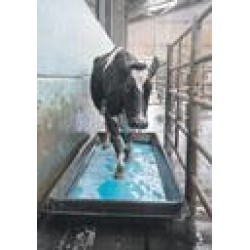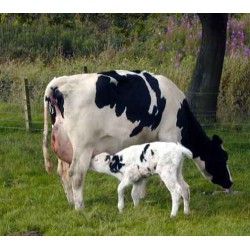Levels of Antibiotic Use- A Dairy Perspective
Levels of Antibiotic Use- A Dairy Perspective.
Dr Graham Shepherd, CEO of Lancashire based G Shepherd Animal Health.
Reducing the use of antibiotics is very high on the agenda for the United Nations, DEFRA, the Chief Medical Officer and supermarket agriculture teams. Agriculture is not a scapegoat here, as it is recognised that most of the human drug resistance is from drug use in humans. However, resistance can cross over both ways and farming should do what it can.
It has been decided that antibiotic resistance is a big problem for the human race and it needs tackling now.
Antibiotic resistance is “infectious” itself! Genes for drug resistance can spread by sections of DNA known as “plasmids”. These plasmids can leave the bacteria and introduce the genes into another bacteria, even a different type of bacteria.
This is obviously a big concern. After all, when we go ill or our cow goes ill, we would prefer that the drugs worked!
It is a global crusade. Recently at the Eurotier exhibition in Germany, I was talking with Chinese pharmaceutical manufacturers who said that they predict a big fall in antibiotic production. At the exhibition they had very few enquiries for antibiotics, but many more for vaccines.
Recently the press has reported that UK farming has done very well in reducing antibiotic use. As ever the devil is in the detail as antibiotic use has slightly increased in cattle (1%), but the significant reduction is from pigs & poultry (23%). On the good side, the overall level of use is much lower in cattle than in pigs and poultry, who used 212 tonnes of antibiotics in 2015.
So, for dairy farming to do its bit we are starting from a relatively lower level of use at 14 tonnes in 2015. Also, there are less bacteria that are resistant to antibiotics in cattle, compared to pigs and poultry.
Antibiotic use in UK dairy farming looks responsible, but the pig & poultry sector have shown big improvements can be made.
Drugs are only used in cattle if they are needed. No one uses them unnecessarily, so the only way to reduce antibiotic use is to reduce the actual need to medicate and to use alternative substances.
Reducing the need to medicate with antibiotics.
It is important to keep it simple, take a broad view and tackle the root causes of disease, because bacterial infections which are often secondary to something else.
Antibiotics should not usually be the first line of defence, but should be used if your Vet prescribes them to treat animals before vaccination and other management changes are put in place. Even after diagnosis and a master plan is implemented, some antibiotics will need to be used at a lower level. A good example of this is even if you vaccinate your calves for pneumonia and have perfect ventilation, some calves still need antibiotics at some time.
“The Balance of Disease”:-
Improve the animal’s immunity-
- Specifically to a particular disease by vaccination
- Generally by good housing, good nutrition
Reduce exposure to the disease causing agent-
- Disinfection
- Ventilation
- Biosecurity
We should always remember that antibiotics are only effective against bacteria. Some antibiotics kill bacteria (e.g. Penicillin), some only stop them breeding (e.g. Oxytetracycline). Bacteria are often ‘secondary invaders’ after viruses (e.g in pneumonia) or physical damage (wounds).
Antibiotics have no effect on Viruses, Cryptosporidia, Coccidia or worms. Also a good immune system is needed to fight infection even if drugs are used. So, it is important to ask “Is the disease caused by or complicated by bacteria?” It is important to “know your enemy!”. For example is it Rotavirus or E.coli or both?
A few points to consider for Youngstock, Lactating Cows & Dry Cows. In all diseases, finding the root cause is important and vaccinate if it is available and effective:-
Youngstock.
Diarrhoea is a very common cause of losses. Colostrum and disinfection are key. Walls and surfaces should be cleanable. Cleaning and disinfection is something that we can learn a lot about from the pig & poultry sector. There are non-drug nutrients with anti-scour functions that we are working with, but no specific claims can be made without investment in a veterinary product licence.
Pneumonia – Adequate ventilation with no draughts, vaccination
Lactating cows- most infections have a metabolic component, often due to Calcium and / or Energy balance. Both of these are subjects in themselves. With regards to Dry Cow management and Calcium, it is vital to have a plan that hopefully works on your farm, most of the time. ( e.g. DCAD, Calcium binders, Calcium drinks and Boluses). Energy intake is greatly improved by good voluntary food intake and forage quality.
Mastitis is usually bacterial so antibiotics are usually needed in the treatment, but all should be done to prevent the bacteria getting up the teat– milking machine function, pre-dip and wipe, cluster flushing, barrier teat dip, teat preparation, disinfectant cubicle powder.
Dry Cows- Reducing routine antibiotic tubes at drying off is seen as the quickest way of reducing dairy antibiotic use. The plan is to use SCC data from milk recordings to identify cows or quarters that need antibiotics. Low SCC quarters are sealed with a Bismuth based tube to prevent bacteria entering the udder during the dry period. Good dry cow management helps avoid metabolic disease and secondary bacterial infections during lactation.
Lameness – A vaccine for Digital Dermatitis is possibly on the horizon. Good nutrition is important to maintain body condition score and the Digital Fat Pad” cushion”. Antibiotics should not be used in footbaths as effective disinfectant alternatives exist.
This article is intended to provide information and stimulate discussion and is in no way an instruction. All health matters are unique to your farm and should be discussed with your Vet.




